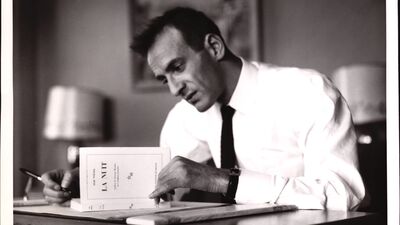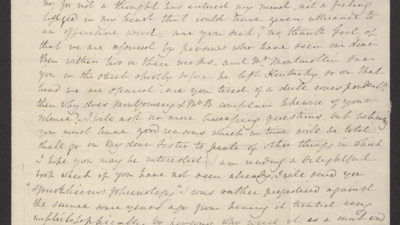Oral History Interview with Lilly Friedman
Title
Date
Contributor
Summary
Lilly Friedman, née Lax, was born in Zarica, Czechoslovakia on January 20, 125. Her father taught Hebrew. Lilly describes how Jewish life and her relations with non-Jews changed after the Hungarian occupation in 1939. In 1944, after the Germans rounded up all the Jews, Lilly and her family were sent to Auschwitz. She describes arrival in Auschwitz, the selections, and brutal murders of infants. After three days she was taken to Plaszow, Krakow with a group of girls for forced hard labor under brutal conditions. In September 1944 they returned to Auschwitz. As transports arrived, women and children were taken straight to the crematoria. After three weeks she was put in charge of 400 of the healthiest girls who were selected to work as weavers in a factory in Neustadt.
As the front came closer, the camp was evacuated. The girls were transported to Mauthausen and then marched to Bergen-Belsen. She gives a graphic description of the transport to Mauthausen by train under Allied bombardment, the casualties and their attempts to help each other. She describes terrible conditions in Bergen-Belsen and how the girls helped each other to survive. They were liberated by the English Second Army April 15, 1945. She slowly regained her health and met and married another survivor. The family came to the United States in March, 1948.
Her daughter, Miriam adds her insights about growing up as a child of survivors. Lilly mentions the impact living through the Holocaust still has on her and her sisters.
Interviewee: FRIEDMAN, Lilly Date: April 21, 1985
More Sources Like This
of
Zenek Maor
Zenek Maor, was born August 9, 1923, in Wloclawek, Poland, into a religious Jewish family. His father was a factory owner and the family lived comfortably until the German occupation. He details pre-war life including his HashomerHatzairactivities. He describes German restrictions and brutalities in Wloclawek, where his father was arrested and held for ransom, and later in Warsaw, where his family fled in January 1940. As a 16 year-old, he worked in various forced labor brigades, including the Okecie air-field in Warsaw. He gives detailed descriptions of life in the Warsaw ghetto including Jewish police and the HashomerHatzairnetwork of underground schools. Because of severe hunger in the ghetto, he was encouraged by his family to escape in 1942.
Eventually sent to various labor camps, he details difficult work conditions but mentions ongoing belief in his own survival. He discusses reasons that people could not escape from labor camps or from Auschwitz. He details his arrival at Auschwitz in summer 1943 including initial belief in the slogan “Work Makes You Free,” the smell of roasting flesh, and his defiance of Mengele’s decision to send him to annihilation with other children instead of assigning him to work with his older brother. Much information is given on Auschwitz: daily routine, work, treatment by Kapos, latrine communication between prisoners. He describes the death march from Auschwitz from January 17, 1945 to May 10, 1945 and gives an in-depth account of his liberation by the Russian Army. Returning to Poland, he learns that no one from his family survived. He emigrated to Palestine in April, 1947.
This interview was conducted in Haifa, Israel.
of
Vera Rosenberger
Vera Rosenberger, nee Weis, was born in Zrenjanin (formerly Petrovgrad) in 1929. She discusses the Jewish community, her relations with Serbs and other non-Jews in Zrenjanin, and her education in public schools. After her father died, they moved to Belgrade. Vera describes the Ashkenazi and Sephardi Jewish communities in Belgrade, as well as Zionist Youth groups, such as Hashomer Hatzair. In 1940 Polish and Australian Jews, including a group of boys and girls on their way to Palestine, fled to Yugoslavia. She lived through the bombardment of Belgrade and the German invasion. Her family fled to Ada, a village in the Baška-which was under Hungarian occupation, one day before Jews had to register with the German authorities. Ada had a prosperous Jewish community but Vera describes the immediate uptick in antisemitism at the arrival of the Hungarians.
In April 20, 1944, during the German occupation, all the Jews in Ada were deported, including Vera and her extended family. After being housed in a synagogue in Szeged, during which time Vera worked at a labor camp in Baja, the group was deported to Auschwitz at the end of May. After a selection in Gässerndorf, Vera was sent to a transit camp in Strasshof, Austria. After several medical examinations, she was sent to work on agricultural farms from dawn to dusk. She briefly mentions the role of the JudenPolizei. She also explains how her mother managed to get medical care.
The American Airforce bombed the station and the railroad tracks the Germans needed to transport all Jews working in Austria to Theresienstadt. So Vera and the other prisoners were brought back to Strasshof. They were liberated by Russian soldiers on April 10, 1945. Vera describes her journey to and her life in Ada after liberation.
Vera left Yugoslavia in 1948. She explains her decision to go to Israel. She reflects on the need to document the history of Yugoslavian Jews and learn the lessons of the Holocaust.
of
Sonja Samson
Sonja Samson was born in Aurich, Germany in 1931, into an assimilated but observant Jewish family. In 1936 she lived with her grandparents in Luxembourg until she joined her parents who had moved to France earlier. She talks about her family history and her childhood, and speculates about her parents’ reasons for staying in France instead of emigrating to the United States. Her father volunteered for the French army but was interned in 1939.
Sonja and her parents were in Gurs briefly, then lived in Garlin, a village near Gurs until August 26, 1942 when they were rounded up by French police, sent to Gurs and then transported to Rivesaltes in September, 1942. Her parents were deported and her mother managed to keep Sonja from going on this transport with the help of Oeuvre de Secours aux Enfants (OSE). She never saw her parents again and still profoundly resents this separation. She briefly describes conditions in the two camps and her life and schooling in the villages of Garlin and Gurs, including pressure on a teacher to rescind an honor Sonja had earned.
Sonja stayed in a convent and then an orphanage at Palavas-les-Flots with other Jewish children, under the auspices of the Union Générale des Israélites de France (UGIF) and OSE, then with distant relatives who were in hiding, later in a boarding school in Chambéry, constantly on guard. She mentions a failed attempt to cross the border into Switzerland.
Later Sonja worked as a maid at an inn that was a substation of the ArmeéSecréte (the French underground). She invented a new identity for herself as a non-Jewish war orphan, and participated in Catholic rites to avoid discovery. After she earned their trust, Sonja became a messenger. She relates how her presence of mind foiled a plot by the so-called “Butcher of Grenoble” to blow up the Underground headquarters just after liberation in August 1944. Sonja describes post-war life at the Chambéry boarding school, with her cousins, as well as her search for her parents, and was an active member of Hashomer Hatzair in Paris. She describes how she learned what she needed to do to survive, how the loss of her parents affects her to this day, and how her outlook about religion, Jewishness, and Zionism changed as she matured.
Sonja went to the United States from Sweden on the Gripsholm as a war-orphan in 1947, instead of making aliyah with her friends. She talks about the difficult adjustment to life in the United States, how she managed to get the higher education she wanted, and post-war trips to Israel in great detail.
Interviewee: SAMSON, Sonja Date: June 3, 1985
of
Lisa G. Tyre
Lisa Tyre was born February 1, 1929 in Vienna, Austria into an assimilated Jewish family. Her father, an attorney, served in the Austrian army in World War I. The family experienced no antisemitism until March 1938. Lisa describes the escalating effects of anti-Jewish measures and activities on her parents and herself and witnessed two instances of brutality against Jews. In the summer of 1938 her father was interrogated and beaten by the GESTAPO. A client, who was a Nazi officer, arranged for his safe return and also helped the family to obtain exit visas. The family left for England in September 1938 – helped by the Sassoon family – and moved to Christ Church, New Zealand six months later. The family went to the United States in November 1946, under the Czech quota and stayed for two weeks in the Congress House a shelter for refugees run by the American Jewish Congress. Lisa describes the difficult emigration process, and her family’s life and adjustment problems in England, New Zealand and the United States. Lisa attributes her rejection of Judaism and her distrust of organized religion to some of her experiences in New Zealand and the Congress House, and her bitterness to the loss of over 50 relatives during the Holocaust.
Interviewee: Tyre, Lisa Glaser Date: February 24, 1981

